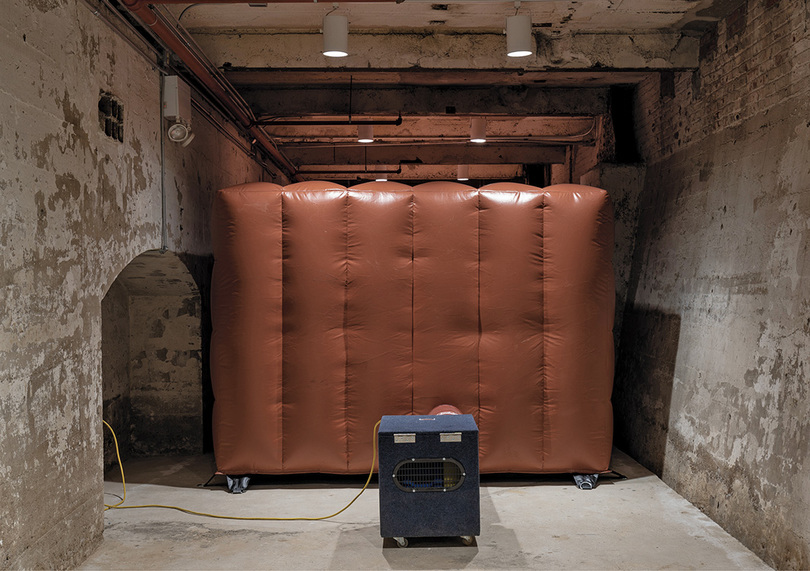
- Source: ARTFORUM
- Author: Lauren O’Neill-Butler
- Date: JANUARY 2022
- Format: PRINT
“Niloufar Emamifar, SoiL Thornton, and an Oral History of Knobkerry”
SCULPTURECENTER

SoiL Thornton, “Husband” chair (SC), 2021, vinyl, D-rings, blower tube, Quiet Box blower. Installation view. Photo: Charles Benton.
For this exhibition in three separate acts—a sort of nongroup group show—Niloufar Emamifar presented works related to SculptureCenter’s archives, spanning its founding as Clay Club in 1928 to the present. The pieces were displayed in the institution’s lower-level warren of narrow hallways. SoiL Thornton blocked an entryway to this sepulchral space with their enormous “Husband” chair (SC), 2021, a brown-vinyl cube attached to a Quiet Box fan, and exhibited a selection of conceptual garments made from materials such as foil, bells, and wire. Upstairs in a compact reading room were complimentary copies of Svetlana Kitto’s Sara Penn’s Knobkerry: An Oral History Sourcebook (2021), which includes press clippings, archival photographs, and fourteen interviews about the titular artist/fashion designer and her revolutionary boutique, Knobkerry. (A PDF of the book was also available on the nonprofit’s website.) On the surface it wasn’t clear how this trio of discrete projects linked up, but notions of access seemed common to all.
This exhibition was atypical in that it truly benefited from a close read—specifically of Kitto’s interviews. We learn that Penn, who passed away in 2020, was an innovative Black businesswoman and a discerning textile buff. Born in Pittsburgh in 1927, she opened Knobkerry in 1965 and over the course of thirty years and across five locations—from New York’s St. Marks Place, East 7th Street, and SoHo to Pasadena, California, and then back to the East Coast in Manhattan’s TriBeCa—she sold an array of international goods, such as “woven ikat robes, Palace Guard robes from Nepal, ceremonial chairs from Africa, and wooden Buddhas,” as fashion editor André Leon Talley reported in a 1977 article for Women’s Wear Daily. One of the images accompanying Talley’s profile of Knobkerry showcases a silver-filigree betel-nut case from India that Penn turned into a minaudière.
Knobkerry was a vital resource for the cultural vanguard: Don Cherry, Ornette Coleman, Jimi Hendrix, and Janis Joplin are mentioned as customers in the book, as are Jean-Michel Basquiat, Louise Bourgeois, and Louise Nevelson. David Hammons staged a subterranean show at the store’s TriBeCa location in 1995. “Just as Sara Penn was more than a shopkeeper, Knobkerry was more than a shop; I’ve heard it described as a gallery, museum, atelier, café, cultural center, salon, and sanctuary,” notes Kitto in her introduction. Above all, it was a successful business, and it did something greater than those contemporaneous brick-and-mortar commercial enterprises of downtown New York’s art scene (such as the artist-run restaurant Food in SoHo and Claes Oldenburg’s Pop-art touchstone The Store, 1961). Fashion writers have credited Knobkerry with pioneering the hippie “Woodstock look.” Knobkerry garments were enthusiastically embraced by various media outlets—from soigné lifestyle glossies to the Saturday Evening Post (its July 27, 1968, issue featured a young and braless Lauren Hutton as its cover girl wearing an assortment of Knobkerry items). Despite her achievements, Penn is relatively unknown, in part due to racism, sexism, and appropriations of Black culture. In a letter addressed to a magazine editor who failed to credit Knobkerry’s contributions in a photo caption, Penn lamented: “If I sound paranoid it is only because I have been a pioneer in my field and watched others walk away with my ideas and gain acceptance and recognition.”
With his assemblage-like approach to organizing the show, curator Kyle Dancewicz managed to dodge those tiresome clichés regarding Penn’s “rediscovery” by an institution, while giving her credit, finally, for her myriad contributions to culture. Still, I would love to have seen some of Penn’s Knobkerry garments and her bespoke objets d’art. That’s a wish I’m planting here for the textile experts at the Costume Institute in New York’s Metropolitan Museum of Art.

